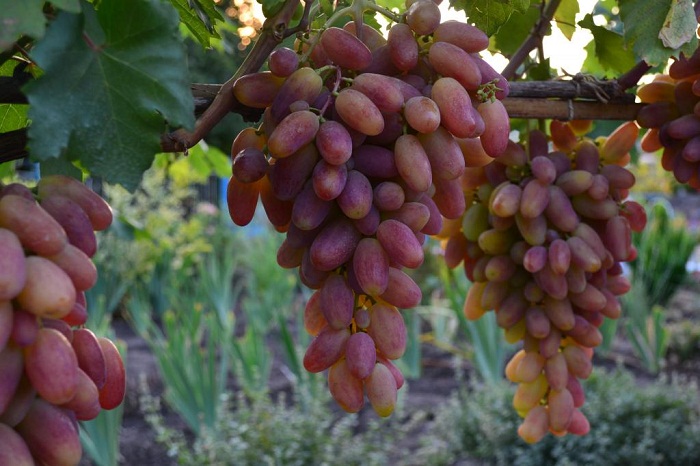 “Transfiguration” grapes are well known to winegrowers in the south of Russia, Ukraine and Belarus. As a cover culture, it is successfully grown in the middle zone of the Russian Federation. The Transfiguration grape variety hybrid is a new author’s work of amateur breeder V. N. Krainov, obtained by crossing the known varieties Kishmish radiant and Talisman.
“Transfiguration” grapes are well known to winegrowers in the south of Russia, Ukraine and Belarus. As a cover culture, it is successfully grown in the middle zone of the Russian Federation. The Transfiguration grape variety hybrid is a new author’s work of amateur breeder V. N. Krainov, obtained by crossing the known varieties Kishmish radiant and Talisman.
Content
Description and specifications
It is too early to search for a description of a variety in the State Register; it has not yet been registered. Amateur gardeners give high marks to grapes. A table variety with early ripening, fruiting twice during the season. The first bunches are removed after 115-120 days from the main bush. The second wave of fruiting occurs later, clusters form in stepsons.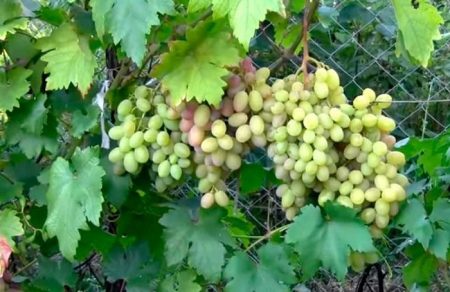
The hybrid is good because it does not require pollinators, it is a self-pollinated species, bisexual flowers form on the bushes. With a high agrotechnical background, it bears fruit stably and intensively, about 20 kg of fruits are removed from one bush. In the southern regions, the main crop is harvested at the end of July.
Fruit
The characteristic of fruits is of particular interest to winegrowers. With the competent formation of the bush and rationing the yield of bunches, the following are formed:
- large;
- conical;
- medium density;
- with a weight of 1.7 to 3 kg.
The clusters are delicious, they consist of large oval-shaped berries. The length of the fruit is about 5 cm, the average weight is 17-20 g. Ripening, the berries are painted in light pink with a slight yellow tint and covered with a white waxy coating. The shape of the fetus is cylindrical, narrowed towards the end.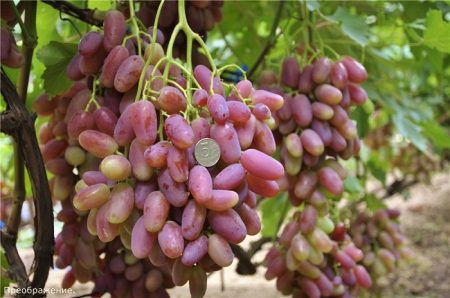
The fruits of the Transfiguration grape are sweet, with a slight acidity. When eating fruits, thin skin does not interfere with enjoying juicy, sweet pulp. The sugar content of the pulp is high (up to 19%), the variety is used as raw material for making wines.
additional characteristics
The variety is chosen for cultivation in a certain climatic zone, so the frost resistance indicator is important for the gardener. Transformation shows an average resistance to frost. Temperatures from -18 ° C and below are fatal to him.
Transfiguration bushes have powerful growth power. A large number of shoots are formed during the season, therefore, for full development and fruiting, it requires all types of pruning:
Choosing this variety for your garden, you need to remember about its features and do not forget to process the vine in a timely manner.
Advantages and disadvantages
A summary table of the main positive and negative characteristics of the variety Transformation will help to make a final assessment.
| Dignity | Disadvantage |
| stable harvest | susceptible to a number of fungal diseases |
| low soil requirements | requires shelter for the winter |
| self-pollination | |
| high quality and taste of fruits | |
| not wrinkling during transportation | |
| suitable for all types of processing (juice, wine) and fresh consumption | |
| relatively frost resistant | |
| missing pea | |
| the crop is little dependent on weather conditions |
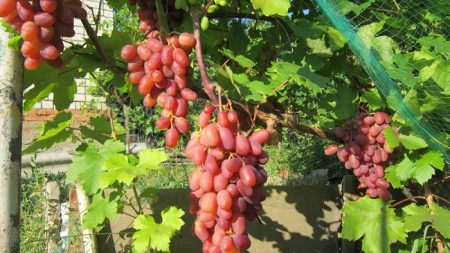
Propagation methods and planting features
Hybrid propagated in two ways. Use either cuttings or ready-made seedlings with an open or closed root system. The exact timing of planting is different, depending on the region of cultivation of grapes. You can plant both in spring and autumn.
When choosing a place for planting vines, many factors are taken into account:
- illumination;
- groundwater depth;
- a rose of winds.
The development of the bush is faster, it comes into fruiting earlier if, when planting, it was successfully chosen a place: well-lit, not in a draft, with low groundwater (below 1.5 m), with cultivated soil.
Preparing the soil and pits for planting
Although the Transfiguration grape is not demanding on the composition of the soil, it is not worth neglecting the preparation of the soil. Many characteristics of the future vine depend on the quality of planting: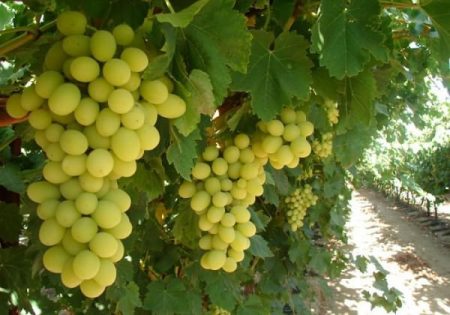
- growth force;
- the beginning of fruiting;
- productivity;
- longevity;
- the quality of the fruit.
Conclusion: the soil for planting needs to be prepared, the higher its fertility, the faster the seedling will take and put forth powerful shoots. A large, properly tucked landing pit, for 3-4 years provides the bush with full nutrition.
The required depth of the planting pit depends on the composition of the soil, the region of cultivation. On clay, moist soils, you need to plant in the hills, in the lowlands they pour a thick layer of gravel into the pits and make ditches to drain the water. In general, it is recommended that Transfiguration grape seedlings be planted in pits up to 50 cm deep and digged at intervals of 2 m.
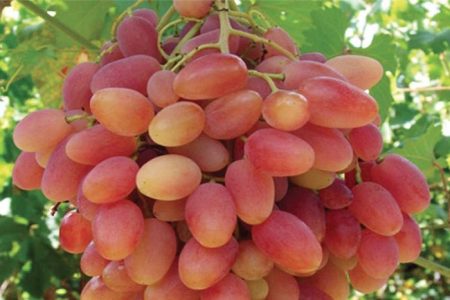
The fertile layer of the earth, taken out of the pit, must be mixed with humus and sand, the ratios are selected in relation to the structure of the soil. As a result, a loose soil mixture should be obtained, it remains to add a standard set of long-acting mineral fertilizers (superphosphate, potassium nitrate) and ash.
Landing and care
Seedlings can be planted in spring and autumn. For a beginner, it is worth specifying the optimal planting dates for experienced winegrowers living in the same area. The main requirement that must be observed during landing is compliance with the depth of landing. After backfilling, the root neck should be on the surface (5 cm from the ground).
Water the seedling. Watering in the first year of life is a job that requires regularity. The formation of vines is badly affected by excess and lack of moisture. Be sure to use mulch: peat, humus, straw. With a sufficient mulching layer thickness (3 cm), moisture and nutrients from the soil do not evaporate.
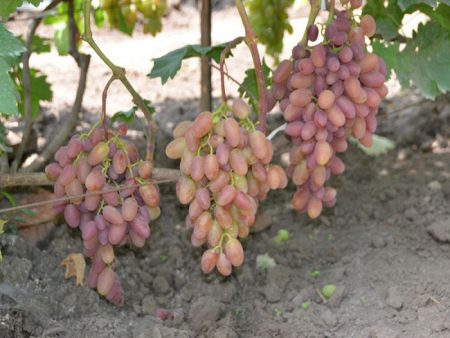
In the spring planting of grapes, mulching is carried out twice. First time in spring, second time in late autumn in preparation for winter. Mulch serves as a prophylaxis of fungal diseases, it eliminates the contact of young shoots with soil and provides an optimal level of moisture in the root zone.
Care for adult plants is standard:
- watering;
- top dressing;
- preventive measures (diseases, pests);
- sanitary pruning in the spring;
- adjusting pruning in the summer;
- forming pruning in the fall;
- mulching;
- removal of basal shoots.
Pruning
In the spring, sanitary pruning is carried out, its purpose is to remove shoots damaged by frost, wind, diseases or pests. In summer grapes Transformation requires regulatory pruning. The harvest of the next year suffers, if you do not control the load of the bush. An overloaded bush reduces the quantity and quality of axillary buds, which will work next year.
To exclude the non-ripening of shoots, you can underload the bush, but do it wisely, avoiding the fattening of vines. Zhiruyuschie vines mature quickly, but suffer frosts worse.Signs of a normal vine along its length (for the south 3 m, for the northern regions no more than 2 m) and thickness (12 mm).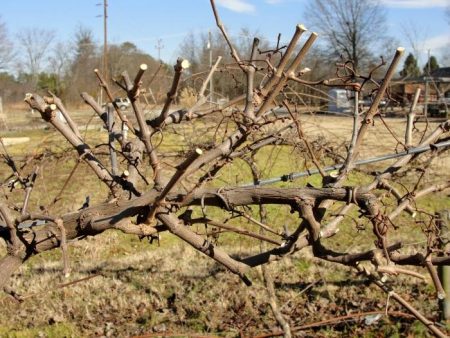
Preobrazhenie grapes are preferred to lead in 2 sleeves, leaving no more than 8 eyes on one shoot. The maximum number of shoots is 25, although, judging by the reviews on the forum, the vine can withstand a large load. It all depends on the level of agricultural background.
To form the vines, they resort to a fan-like pruning method, leaving several fruit links on each bush. Attach the shoots to a vertically mounted trellis. The first time forming pruning is carried out a year after planting and is done annually for 5 years.
It is better to form a bush in 2 sleeves, cutting out fruit-bearing shoots in autumn, leaving the required number of substitution and fruiting shoots every year. 12 eyes leave on the fruiting vine, always 2 each on the shoot of substitution.
Diseases and Pests
The hybrid does not have 100% immunity to fungal diseases. Shoots and leaves can be affected by downy mildew (mildew) and oidium (powdery mildew). Bacterial cancer on plants develops through the fault of winegrowers when they use dirty tools. Cancer is not treated, the diseased vine is uprooted. Spotted necrosis can appear in the spring after an unfavorable wintering.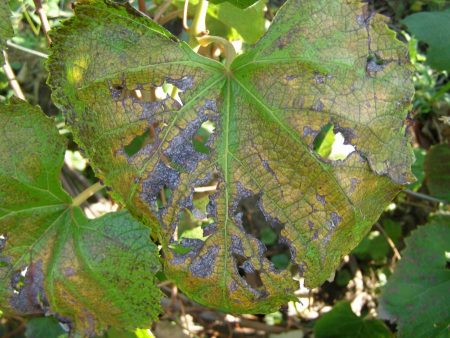
Of the grape pests, Transfiguration is a threat:
- mite;
- pads;
- mole;
- flea.
These are varieties of insects that live on grapes.
Reviews
Alexey, Stavropol Territory
A vigorous variety, the vine ripens, no sprouting. Self-pollinating, fruit set is good. I admit a load of 30-35 shoots per bush, on each I leave 6-8 eyes. Bunches of commodity from 700 to 1500 g; berries do not crumple during transportation. The fruits are large - 25 g, medium and small from 12 to 18 g. I practiced pruning for 2-4 buds, the harvest was not bad.
Pavel, Volgograd region
My Transfiguration is ripening in the first ten days of August. I noticed the influence of the sun on the color of fruits - they are pale in the shade, and pink in the sun.
Vladimir, Moscow Region
In our suburbs Kraynova variety has time to ripen. I harvest my crop from late July to mid-August. Weather affects the timing. Each bush has an individual approach - its own load. Load normalization allows you to get a crop in any summer.

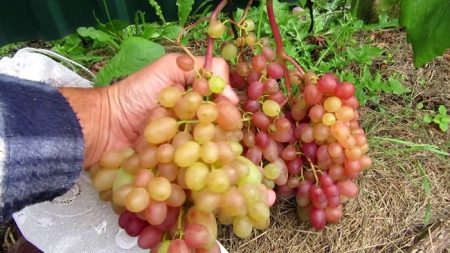



 Non-covering winter-hardy grape varieties for Moscow region
Non-covering winter-hardy grape varieties for Moscow region How to keep the vine in winter
How to keep the vine in winter When can I transfer grapes to another place in the fall
When can I transfer grapes to another place in the fall How to cover and prepare grapes for the winter in the suburbs
How to cover and prepare grapes for the winter in the suburbs